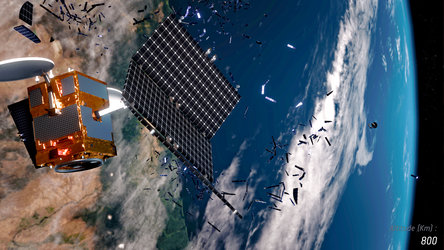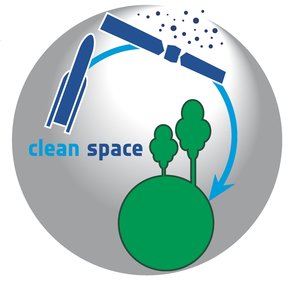International consensus on debris threat
Findings from the 7th European Conference on Space Debris
Despite progress in technology, and in understanding the space environment, the need for significantly increasing the pace in applying proposed measures to reduce debris creation has been identified at Europe’s largest-ever space debris conference.
In this context, recent announcements of large constellations with several hundreds of satellites in critical orbital regimes has been identified as a potential additional challenge.
These were among the findings presented by senior scientists and representatives of the world’s leading space agencies and space-related scientific bodies during a press briefing from the week-long 7th European Conference on Space Debris at ESA’s mission control centre in Darmstadt, Germany, today.
As the world's largest scientific gathering dedicated to space debris, the event saw best-ever attendance by some 350 participants from space organisations, academia and industry who delivered hundreds of papers on the latest research into the debris threat and on new technologies aimed at mitigating debris creation and reducing the orbital debris population.
There was wide agreement that the continuing growth in space debris poses an urgent threat to economically and scientifically vital orbital regions.
Today’s active satellite infrastructure includes telecom, weather, navigation, broadcast and climate-monitoring missions, and these provide a multitude of critical services and daily benefits to citizens and economies. Their loss, due to their orbits being polluted by debris, would severely damage modern society.
There is a consensus that debris mitigation strategies defined long ago are important today as never before. The venting of residual energy from satellites and upper stages at the end of their missions to prevent explosive break-ups and the disposal of any sort of satellite through a final manoeuvre remain challenges.
Numerous novel solutions were presented to support these important mitigation measures. Many presentations emphasised that execution of these measures is becoming ever more important in view of the upcoming megaconstellationsof thousands of satellites in low orbit.
“Fast and reliable implementation of mitigation measures for all missions and a change in the operational paradigm to consider space-object disposal as an important part of the overall mission are essential to contain the growth of the space debris population and to preserve space for future generations,” said Holger Krag, Head of ESA’s Space Debris Office and conference chair.
“The conference demonstrated that the technology is available and the need is understood everywhere.
“However, implementation of these countermeasures is still a challenge, and this has the utmost importance in view of plans to deploy constellations of hundreds of satellites in space.”
Like all missions, such constellations must include provision for safe disposal when their missions end so that they do not contribute to the already unsustainably large population of debris objects.
Since 1957, more than 5250 space launches have led to an on-orbit population today of more than 23 000 tracked debris objects.
Only about 1200 are functional spacecraft. The remaining are classified as space debris and no longer serve any useful purpose. A large percentage of the routinely tracked objects are fragments from the approximately 290 breakups, explosions and collisions of satellites or rocket bodies that are known to have occurred.
An estimated 750,000 objects larger than 1 cm and a staggering 166 million objects larger than 1 mm are thought to reside in commercially and scientifically valuable Earth orbits.
Mitigation map is in place
Space debris mitigation measures have been adopted by most major space-faring agencies and companies and, if properly implemented by spacecraft designers and mission operators, can curtail the growth rate of the orbital debris population.
Active removal, however, is now necessary to reverse the debris increase, and researchers have seen evidence that the environment in some orbital regions has already reached a critical state.
“The number of space debris objects in these regions might grow even if mitigation measures are applied,” says Dr Krag.
To prevent this uncontrolled growth, the active removal or deorbiting of selected large defunct space objects is required in addition to the full application of mitigation measures.
“The technology required for deorbiting is actively being studied today and we saw a lot presented at this conference.”
Even then, the serious shortfall debris mitigation guideline adherence – and specifically post-mission disposal practices – that were identified by conference participants may yet render such efforts moot.
“We see evidence that fewer than half of the satellites that should be deorbited at end of life are actually commanded to do so, and there is no enforceable international regime to ensure this,” says Dr Krag.
“It’s the classic ‘tragedy of the commons’, except it’s happening in space and could ruin modern technological society for everyone.”
Global gathering of debris experts
The findings were delivered by researchers and specialists of more than 20 spacefaring nations.
The scientific programme board of the conference was supported by experts from the DLR German Aerospace Center, France’s CNES space agency, Italy’s ASI space agency, the UK Space Agency, the Committee on Space Research, the International Academy of Astronautics and ESA.
For the first time in the 24 year history of the quadrennial debris conference series, the media briefing was attended by ESA Director General Jan Wörner and Brigitte Zypries, German Federal Minister for Economic Affairs and Energy and German national aerospace coordinator






